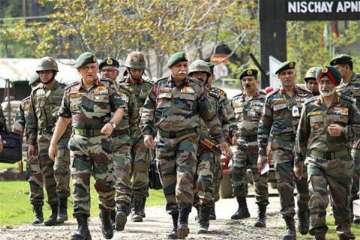The Indian Army is set to deploy its first Integrated Battle Group (IBG) along the frontier by the end of this year, Army Chief General Bipin Rawat said. The move comes in the wake of rising tensions between India and Pakistan over the abrogation of Article 370 in Jammu and Kashmir, which granted a special status to the state.
According to media reports, the Indian Army plans to form and deploy 11 -13 IBGs to protect its western and eastern borders.
The ministry of defence (MoD) has cleared the reorganisation of IX Corps, based in Yol in Himachal Pradesh, to form the IBGs to be deployed along the western border. Raised in 2009, IX Corps is one of the army’s youngest corps and is part of the Chandimandir, Haryana-based Western Army Command.
This is one of the biggest reorganisations of the Army and General Rawat is its prime mover.
Commenting on the development, Army Chief General Bipin Rawat said, "The international border portion of J&K Kashmir will see reorganisation first followed by others, making the Indian army a leaner and meaner fighting unit."
Restructuring of the combat potential of the Indian army will happen “selectively from sector to sector,” he added.
According to media reports, the Integrated Battle Groups are smaller, meaner, self-contained fighting units, including elements of airpower, artillery, amour.
Depending upon the terrain where it is deployed and the purpose, the IBG will also encompass 6-8 battalions. The composition of the IBGs will vary depending on the “task” and the “order of battle,” said a senior Army officer who did not want to be named.
“The IBGs, on an average, would comprise 20,000- 25,000 men,”said the officer. While each IBG will be a self-contained fighting unit, it can draw logistical support from other formations. The IBGs will be smaller and more flexible, allowing faster mobilisation. The formation of the IBGs, among other things, will drastically cut the time required to mobilise the strike arms of the Army. Each IBG will be commanded by an officer of the rank of major general.
The Siliguri-based XXXIII Corps, tasked with protecting the Indo-Tibetan border including Sikkim, is next in line for being transformed into an IBS. The XXXIII Corps, which moved to its present location in 1962, comprises the Black Cat, Kirpan and Striking Lion divisions and an artillery division – an estimated 30,000 thousand soldiers.
The XXXIII Corps is likely to be reorganised into five IBGs, each tasked differently, asecond senior officer requesting anonymity said. The recently raised, Panagarh, West Bengal-based Mountain Strike Corps, or Brahmastra Corps, the only strike corps designated to fight along the India-China border, will also be restructured to form three IBGs.
Also Read | Pakistan violates ceasefire in Poonch, one Army personnel martyred
Also Read | Army Chief reviews security situation along LoC in Jammu region
Army chief General Bipin Rawat meets troops along LoC
Latest India News

